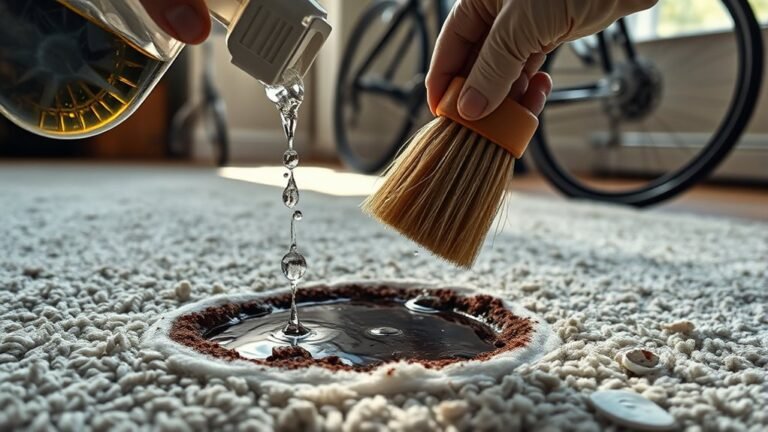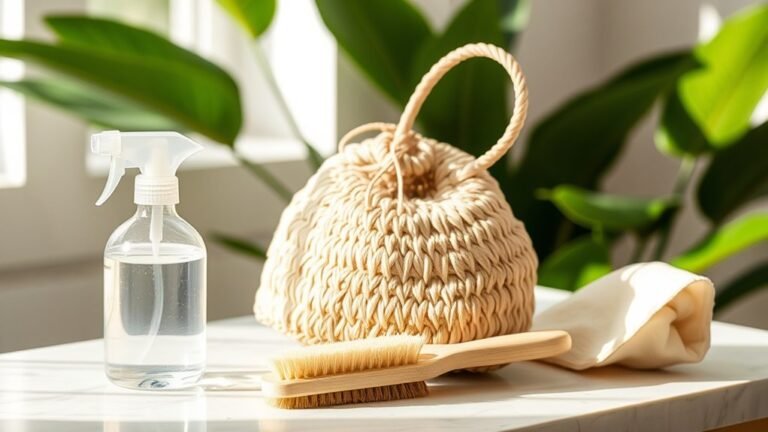Top 10 Tips for Cleaning Stains
To tackle stains effectively, act fast to stop them from setting, and always blot gently instead of rubbing. Use cold water for protein stains and apply baking soda on grease spots. Vinegar works well on ink, while dish soap pre-treats food stains. Avoid heat until the stain’s gone, and test cleaning products on hidden areas first. Follow your garment’s care label to avoid damage. Keep these tips in mind, and you’ll find even more ways to get fabrics spotless.
Act Quickly to Prevent Stains From Setting
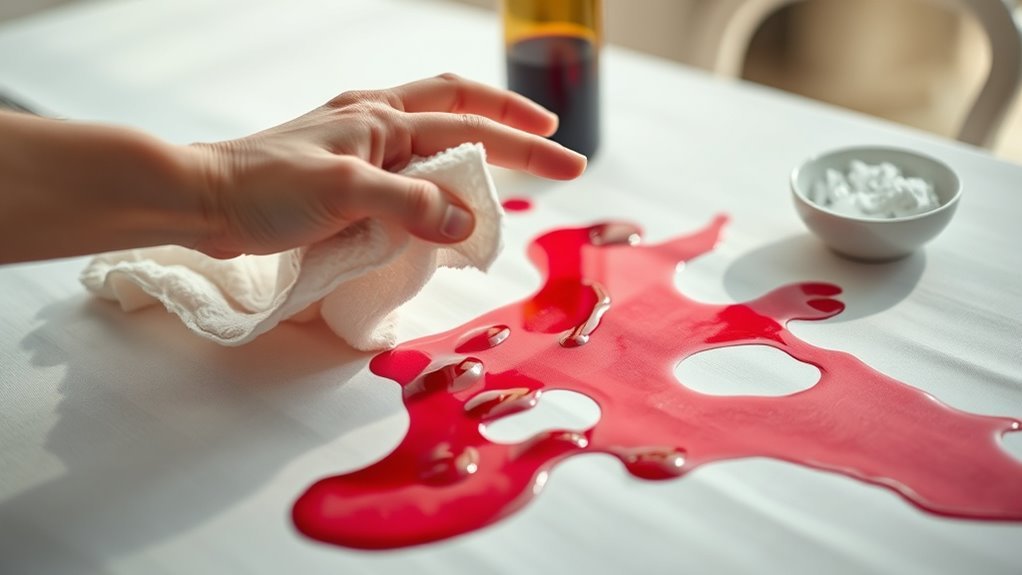
Although it might be tempting to wait, you should act quickly when a stain occurs. Taking immediate action is one of the most effective stain prevention techniques you can use. The longer a stain sits, the deeper it settles, making it harder to remove and limiting your freedom to wear or use your favorite items without worry. By responding right away, you control the situation instead of letting the stain dictate your options. Keep essential cleaning supplies handy so you’re always ready to tackle stains head-on. This approach guarantees you maintain control over your belongings and your time, allowing you to move freely without the stress of stubborn stains slowing you down. Remember, quick response is your best defense against permanent marks.
Blot, Don’t Rub, to Avoid Spreading Stains
When you spot a stain, you’ll want to blot it gently instead of rubbing. Rubbing only spreads the stain, making it harder to remove. Mastering simple blotting techniques helps maximize stain absorption without damaging the fabric. Use a clean cloth or paper towel to press down lightly, lifting the stain away. This approach keeps your freedom intact—no stubborn marks holding you back.
| What to Use | How to Blot |
|---|---|
| Clean white cloth | Press gently, don’t rub |
| Paper towel | Dab repeatedly, absorb well |
| Cotton ball | Light, controlled blotting |
| Sponge | Blot edges toward center |
| Absorbent napkin | Repeat until no more stain |
Blotting stops stains from spreading and gives you control over the cleanup process.
Use Cold Water for Protein-Based Stains
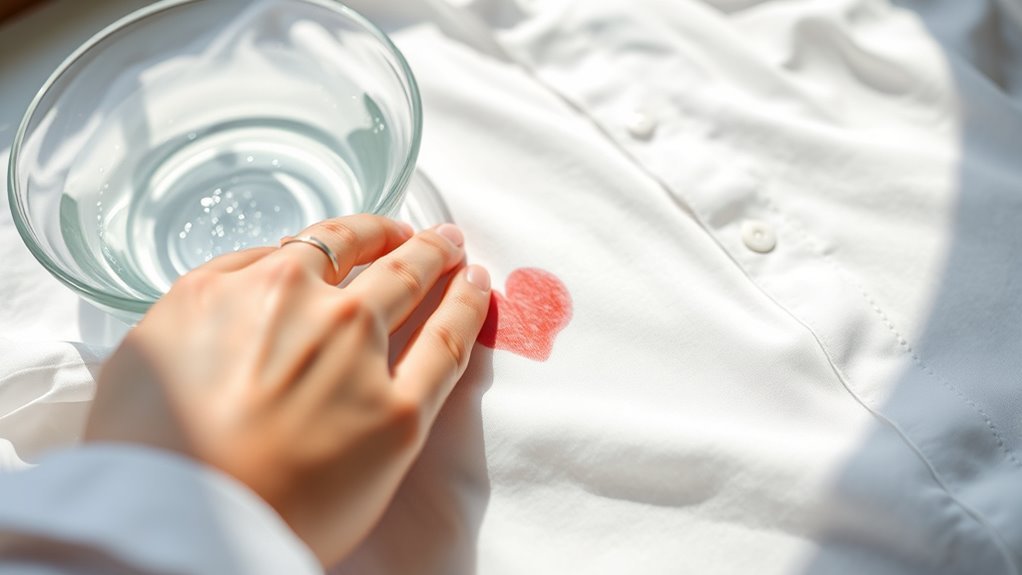
Since protein-based stains like blood, sweat, and dairy can set quickly, you’ll want to use cold water to rinse them out immediately. Hot water can actually cause these stains to bond with fabric fibers, making removal tougher. Cold water effectiveness lies in its ability to loosen and lift protein stains without cooking them in. When you act fast and rinse with cold water, you’re giving yourself the best shot at protein stain removal. Don’t just soak the stain—gently rinse it under a cold stream or soak the fabric briefly. This simple step frees you from stubborn spots that hold you back. Embrace this quick, easy method to keep your clothes looking fresh and stain-free, giving you the freedom to enjoy life without worrying about mishaps.
Apply Baking Soda for Oil and Grease Stains
When tackling oil and grease stains, baking soda is your best friend because it absorbs excess oil and lifts stains effectively. You’ll want to sprinkle it generously over the stain, let it sit for 15-30 minutes, then brush it off before washing. This simple technique can save your clothes and surfaces from stubborn grease marks.
Baking Soda Benefits
If you’ve ever struggled with stubborn oil or grease stains, baking soda can be a game-changer. Its unique baking soda properties—like gentle abrasiveness and natural absorbency—make it perfect for lifting stains without harsh chemicals. You’ll love the freedom to clean effectively with a safe, eco-friendly ingredient. Baking soda uses extend beyond stain removal, but when it comes to oil and grease, it absorbs excess oils and neutralizes odors, leaving fabrics fresh. Here’s a quick look at its benefits:
| Benefit | Description | Why It Matters |
|---|---|---|
| Absorbent | Draws out grease and oil | Prevents stains setting |
| Mild Abrasive | Breaks down tough residue | Protects fabric fibers |
| Odor Neutralizer | Eliminates unpleasant smells | Keeps items fresh |
| Non-Toxic | Safe for kids and pets | Peace of mind |
| Versatile | Works on many surfaces | Saves time, money |
Application Techniques
Baking soda’s stain-fighting benefits are only as effective as how you apply it. For oil and grease stains, choosing the right application methods gives you the freedom to tackle messes confidently. Start by sprinkling a generous layer of baking soda directly onto the fresh stain—it acts like a magnet, absorbing the oil. Let it sit for 15 to 30 minutes to maximize stain removal. Then, gently brush off the powder, avoiding rubbing, which can spread the stain. If needed, repeat the process or combine with a mild detergent for tougher spots. These simple, precise application techniques empower you to reclaim your fabrics without harsh chemicals or extra hassle. With the right method, baking soda becomes your go-to ally for clean, stain-free freedom.
Try Vinegar Solutions for Ink and Dye Stains
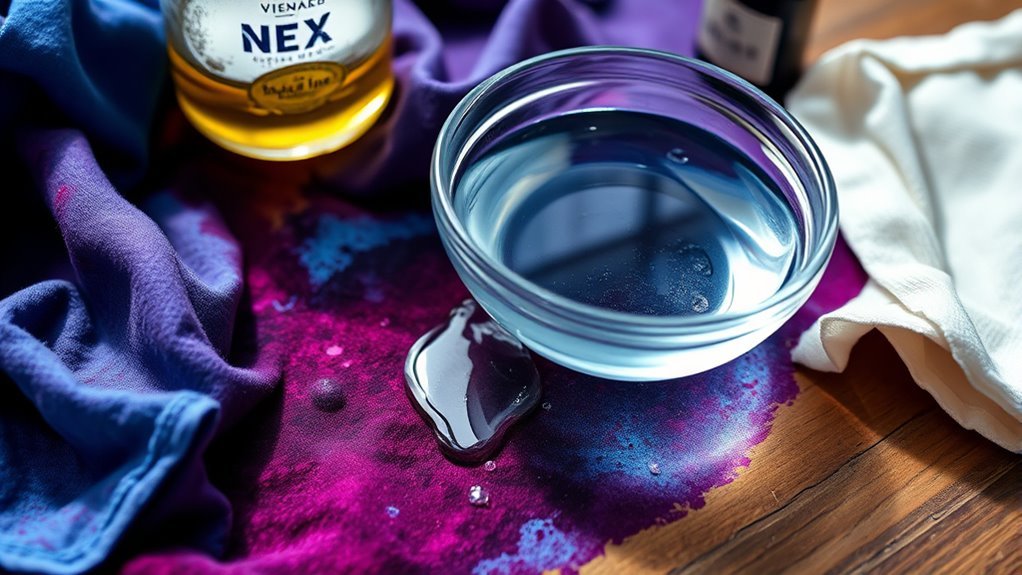
Although ink and dye stains can be stubborn, you can often remove them effectively with a vinegar solution. Vinegar effectiveness lies in its natural acidity, which breaks down the pigments in ink and dye, making removal easier without harsh chemicals. To try this, mix equal parts white vinegar and water, then dab the solution onto the stain using a clean cloth. Avoid rubbing, as that can spread the stain. Let it sit for a few minutes to penetrate the fibers, then blot gently. Repeat if necessary, rinsing with cold water afterward. This simple method empowers you to tackle ink removal with confidence, freeing your fabrics from unwanted marks while keeping things eco-friendly and straightforward. Give it a shot and reclaim your freedom from stubborn stains!
Utilize Hydrogen Peroxide for Tough Organic Stains
Vinegar works wonders on ink and dye stains, but when you’re facing tougher organic stains like blood or wine, hydrogen peroxide can be your best ally. It’s a powerful, yet accessible solution that breaks down stubborn organic stains quickly, giving you the freedom to enjoy spotless fabrics without harsh chemicals.
Here’s how to use hydrogen peroxide effectively:
- Test a small, hidden area first to verify colorfastness and avoid damage.
- Apply hydrogen peroxide directly to the organic stain and let it fizz for a few minutes.
- Blot gently with a clean cloth and rinse with cold water; repeat if necessary.
With these simple steps, you’ll reclaim your clothes and upholstery from tough organic stains effortlessly.
Pre-Treat With Dish Soap for Food and Beverage Stains
When you spot food or beverage stains, grab a mild dish soap to tackle them effectively. Apply it directly onto the stain and let it sit for a few minutes to break down the residue. This simple step helps loosen the stain before you wash, making removal much easier.
Choose Mild Dish Soap
Since food and beverage stains can be stubborn, choosing a mild dish soap for pre-treating is a smart move. Mild dish soap offers several benefits that make stain removal easier without damaging your fabrics or surfaces. If you want to keep your options open, consider dish soap alternatives like castile soap or eco-friendly brands.
Here’s why mild soap benefits you:
- Gentle on fibers: It breaks down stains but won’t wear out your clothes or upholstery.
- Safe for sensitive skin: Reduces irritation if you’re handling stained items frequently.
- Versatile use: Works well on a variety of food and beverage stains without harsh chemicals.
Choosing the right soap gives you freedom to clean effectively and safely every time.
Apply Directly on Stain
Although it might seem simple, applying dish soap directly to a stain is an essential step in breaking down food and beverage residues effectively. When you pre-treat stains this way, you target the problem right at its source, making stain removal much easier. You don’t need fancy products—just a bit of mild dish soap applied straight onto the spot. Gently rub it in using your fingers or a soft cloth to loosen the stain without damaging the fabric. This approach is one of the most straightforward cleaning techniques you can use, giving you the freedom to tackle messes confidently and independently. Remember, direct application helps lift stains, saving you time and effort in your cleaning routine.
Let Sit Before Washing
If you want the dish soap to break down food and beverage stains effectively, you should let it sit on the fabric for a few minutes before washing. This waiting period is essential because it gives the soap time to penetrate and loosen the stain, freeing you from stubborn marks.
To get the best duration and best results, follow these steps:
- Apply a small amount of dish soap directly to the stain.
- Let sit for 5 to 10 minutes—this best duration guarantees the soap works without damaging the fabric.
- Wash as usual with your preferred settings.
Avoid Heat Until Stains Are Fully Removed
Before you apply any heat to a stained fabric, make sure the stain is completely gone. Heat can set stains permanently, making stain removal tougher or even impossible. When you use hot water, a dryer, or an iron too soon, you risk heat damage that locks in the stain. Take your time to treat the stain thoroughly with the right methods before turning up the temperature. Hold onto your freedom to rescue your clothes—don’t rush into heat until you’re sure the stain’s vanished. By avoiding heat early on, you keep your options open for effective stain removal and protect your fabric’s longevity. Remember, patience here saves your garments and keeps your cleaning efforts successful.
Test Cleaning Products on a Hidden Area First
Before applying any cleaning product, try it on an inconspicuous spot to avoid surprises. Watch closely for any discoloration or damage that might occur. This quick test helps you see how the product reacts without ruining the whole item.
Choose Inconspicuous Spot
Where should you test a new cleaning product to avoid damage? Always pick an inconspicuous spot first. This lets you see how the product reacts without risking visible damage. Different fabric types react differently, so it’s key to find a hidden area that mirrors the main surface. Here’s where to try:
- Inside seams or hems – usually out of sight and great for testing invisible stains treatments.
- Underneath cushions or folds – these spots are less exposed and ideal for sensitive fabrics.
- Backside of rugs or curtains – perfect for checking colorfastness without anyone noticing.
Check for Discoloration
Testing a cleaning product on a hidden area gives you a clear idea of how it affects your fabric’s color. Discoloration causes vary, from chemical reactions to fabric sensitivity. You want to avoid surprises like fading or staining. Here’s a simple table to guide you through common discoloration types and their causes:
| Discoloration Type | Cause | What to Watch For |
|---|---|---|
| Fading | Harsh chemicals | Color lightening |
| Bleaching | Chlorine in cleaners | White or pale spots |
| Staining | Residue from product | Darker patches |
| Color Transfer | Dye bleeding | New colors on fabric |
Checking this beforehand keeps your freedom intact, so you can clean confidently without damaging your favorite fabrics.
Test Product Reaction
Although it might seem like an extra step, trying a cleaning product on a hidden spot is the best way to avoid damage. Different fabric types react differently to stain removal solutions, so testing guarantees your freedom to clean without risking discoloration or texture changes. Here’s how to do it right:
- Choose a discreet area on the fabric, like an inside seam or hem.
- Apply a small amount of the cleaning product and wait 5-10 minutes.
- Check for any fading, color change, or fabric damage before proceeding.
Follow Care Labels and Manufacturer Instructions
Before you tackle any stain, make sure you carefully read the care labels and follow the manufacturer’s instructions. These labels are your roadmap to proper laundry care, tailored to different fabric types. Ignoring them can lead to damage or color fading, limiting how freely you can wear your clothes. Each fabric reacts differently to cleaning agents and temperatures, so respecting these guidelines protects your garments and keeps them looking fresh. Don’t assume all stains need the same treatment—what works for cotton might ruin silk or wool. By following care labels, you maintain your freedom to enjoy your clothes longer without worry. So, embrace these instructions as your ally in stain removal, ensuring your laundry care routine respects both your style and the fabric’s needs.
Frequently Asked Questions
How Can I Prevent Stains on Upholstery and Carpets?
To prevent stains on upholstery and carpets, you’ll want to focus on stain prevention and upholstery maintenance. Act quickly if spills happen, blotting instead of rubbing to avoid setting stains. Use protective sprays designed for fabrics to create a barrier. Regular vacuuming helps keep dirt from embedding. Also, consider using washable slipcovers or rugs in high-traffic areas to keep your space looking fresh and give you the freedom to enjoy your home without worry.
What Are the Best Stain Removers for Delicate Fabrics?
When dealing with delicate fabrics, you’ll want to choose gentle stain removers specifically designed for them. Look for products labeled as safe for silk, wool, or lace, avoiding harsh chemicals that can damage fibers. Natural options like diluted white vinegar or a mild detergent mixed with water work well too. Always test any remover on a hidden area first to make sure your fabric stays vibrant and intact while freeing it from stains.
Can Natural Remedies Replace Commercial Stain Removers?
You want freedom, you want safety, you want effectiveness. Natural alternatives can sometimes match commercial stain removers in stain effectiveness, especially for fresh or light stains. They’re gentler on delicate fabrics and kinder to the environment. However, they might not always erase tough, set-in stains as quickly. You can try using things like vinegar, baking soda, or lemon juice, but be ready to experiment and embrace the natural path to cleaner clothes.
How Do I Remove Stains From Leather or Suede?
When dealing with stains on leather or suede, you’ve got to approach with care. For leather, gently dab a mixture of mild soap and water, then condition it to keep that leather care going strong. Suede maintenance means no water—use a suede brush or eraser to lift stains and restore texture. Remember, treating those stains quickly helps you keep your freedom to wear your favorite pieces without worry.
What Should I Do if a Stain Persists After Cleaning?
Imagine a stubborn stain clinging like a shadow refusing to fade. If a stain persists after cleaning, don’t give up freedom to your fabrics just yet. Explore advanced stain removal techniques—dab gently with a mixture of mild detergent and water or try specialized cleaners designed for tough spots. For persistent stain solutions, sometimes patience and repeated gentle treatments are key, letting your fabrics breathe and regain their original, unburdened look.

